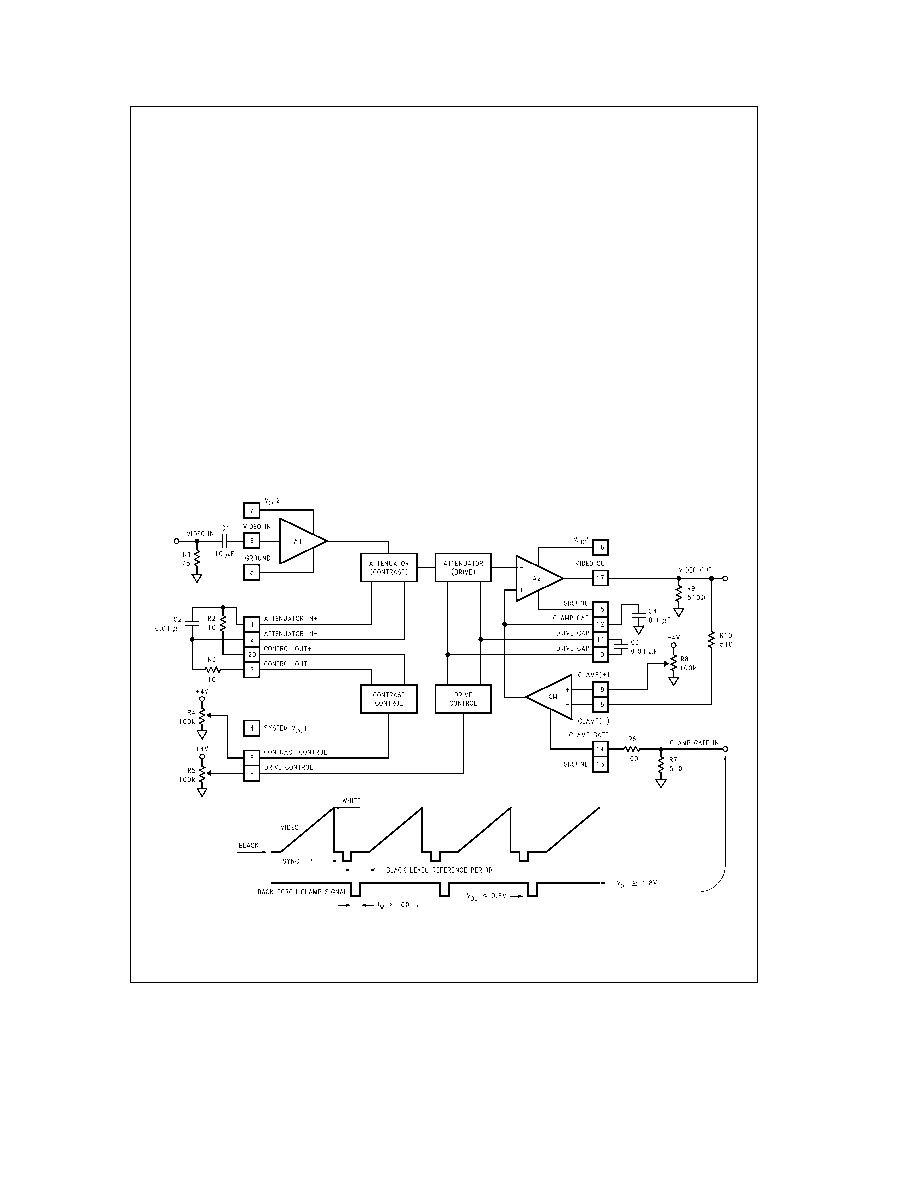 | –≠–ª–µ–∫—Ç—Ä–æ–Ω–Ω—ã–π –∫–æ–º–ø–æ–Ω–µ–Ω—Ç: LM1202 | –°–∫–∞—á–∞—Ç—å:  PDF PDF  ZIP ZIP |

TL H 11440
LM1202
230
MHz
Video
Amplifier
System
December 1995
LM1202 230 MHz Video Amplifier System
General Description
The LM1202 is a very high frequency video amplifier system
intended for use in high resolution monochrome or RGB
color monitor applications In addition to the wideband video
amplifier the LM1202 contains a gated differential input
black level clamp comparator for brightness control a DC
controlled attenuator for contrast control and a DC con-
trolled sub contrast attenuator for drive control The DC
control for the contrast attenuator is pinned out separately
to provide a more accurate control system for RGB color
monitor applications All DC controls offer a high input im-
pedance and operate over a 0V to 4V range for easy inter-
face to bus controlled alignment systems The LM1202 op-
erates from a nominal 12V supply but can be operated with
supply voltages down to 8V for applications that require re-
duced IC package power dissipation characteristics
Features
Y
Wideband video amplifier
(f
b
3dB
e
230 MHz at V
O
e
4 V
PP
)
Y
t
r
t
f
e
1 5 ns at V
O
e
4 V
PP
Y
Externally gated comparator for brightness control
Y
0V to 4V high input impedance DC contrast control
(
l
40 dB range)
Y
0V to 4V high input impedance DC drive control
(
g
3 dB range)
Y
Easy to parallel three LM1202s for optimum color track-
ing in RGB systems
Y
Output stage clamps to 0 65V and provides up to 9V
output voltage swing
Y
Output stage directly drives most hybrid or discrete
CRT amplifier stages
Applications
High resolution CRT monitors
Video switches
Video AGC amplifier
Wideband amplifier with gain and DC offset control
Block and Connection Diagram
TL H 11440 ≠ 1
Order Number LM1202N or LM1202M
See NS Package Number N20A or M20B
C1996 National Semiconductor Corporation
RRD-B30M66 Printed in U S A

Absolute Maximum Ratings
(Note 1)
If Military Aerospace specified devices are required
please contact the National Semiconductor Sales
Office Distributors for availability and specifications
Supply Voltage V
CC
Pins 4 7 16 to
Ground Pins 5 13 15
13 5V
Voltage at Any Input Pin (V
IN
)
V
CC
t
V
IN
t
GND
Video Output Current (I
17
)
28 mA
Package Power Dissipation at T
A
e
25 C
1 56W
(Above 25 C Derate Based i
JA
and T
J
)
Package Thermal Resistance (i
JA
)
N20A
68 C W
M20B
90 C W
Junction Temperature (T
J
)
150 C
Storage Temperature Range (T
stg
)
b
65 C to
a
150 C
Lead Temperature
N Package (Soldering 10 sec )
265 C
ESD Susceptibility
Human Body Model 100 pF Discharged
1 5 kV
through a 1 5k Resistor
Operating Ratings
(Note 2)
Temperature Range
b
20 C to
a
80 C
Supply Voltage (V
CC
)
8V
s
V
CC
s
13 2V
DC Electrical Characteristics
See Test Circuit
(Figure 1) T
A
e
25 C V4
e
V7
e
V16
e
12V S1 Open
V19
e
4V V8
e
4V V9
e
4V V14
e
0V unless otherwise noted
Symbol
Parameter
Conditions
Typical
Limit
Units
(Note 3)
(Note 4)
I
S
4 7 16
Total Supply Current
R
Load
e
%
(Note 5)
48
60
mA (max)
V
6
Video Input Bias Voltage
2 4
2
V (min)
V
14L
Clamp Gate Low Input Voltage
Clamp Comparator On
0 8
V (max)
V
14H
Clamp Gate High Input Voltage
Clamp Comparator Off
2
V (min)
I
14L
Clamp Gate Low Input Current
V
14
e
0V
b
0 5
m
A
I
14H
Clamp Gate High Input Current
V
14
e
12V
0 005
m
A
I
12a
Clamp Cap Charge Current
V
12
e
0V
800
500
m
A (min)
I
12b
Clamp Cap Discharge Current
V
12
e
5V
b
800
b
500
m
A (min)
V
17L
Video Output Low Voltage
V
12
e
0V
0 2
0 65
V (max)
V
17H
Video Output High Voltage
V
12
e
6V
10
9
V (min)
V
OS
Comparator Input Offset Voltage
V
18
b
V
19
15
g
50
mV (max)
AC Electrical Characteristics
See Test Circuit
(Figure 1) T
A
e
25 C V4
e
V7
e
V16
e
12V S1 Closed
V19
e
4V V8
e
4V V9
e
4V V14
e
0V unless otherwise noted
Symbol
Parameter
Conditions
Typical
Limit
Units
(Note 3)
(Note 4)
R
IN
Video Amplifier Input Resistance
f
IN
e
12 kHz
20
kX
A
V
max
Video Amplifier Gain
V
8
e
4V V
9
e
4V
20
16
V V (min)
D
A
V
2V
Attenuation at 2V
Ref A
V
max V
8
e
2V
b
6
dB
D
A
V
0 5V
Attenuation at 0 5V
Ref A
V
max V
8
e
0 5V
b
38
b
23
dB (min)
D
Drive
D
Gain Range
V
9
e
0V to 4V
6
5
dB (min)
THD
Video Amplifier Distortion
V
O
e
4 V
PP
f
IN
e
12 kHz
0 5
1
% (max)
f
b
3 dB
Video Amplifier Bandwidth (Note 6)
V
O
e
4 V
PP
230
MHz
t
r
Output Rise Time (Note 6)
V
O
e
4 V
PP
1 5
2
ns (max)
t
f
Output Fall Time (Note 6)
V
O
e
4 V
PP
1 5
2
ns (max)
http
www national com
2

Electrical Characteristics
(Continued)
Note 1
Absolute Maximum Ratings indicate limits beyond which damage to the device may occur
Note 2
Operating Ratings indicate conditions for which the device is functional but do not guarantee specific performance limits For guaranteed specifications and
test conditions see the Electrical Characteristics The guaranteed specifications apply only for the test conditions listed Some performance characteristics may
degrade when the device is not operated under the listed test conditions
Note 3
Typical specifications are specified at
a
25 C and represent the most likely parametric norm
Note 4
Tested limits are guaranteed to National's AOQL (Average Outgoing Quality Level)
Note 5
The supply current specified is the quiescent current for V
CC1
V
CC2
and V
CC3
with R
Load
e
%
see
Figure 1's test circuit The total supply current also
depends on the output load R
Load
The increase in device power dissipation due to R
Load
must be taken into account when operating the device at the maximum
ambient temperature
Note 6
When measuring video amplifier bandwidth or pulse rise and fall times a double sided full ground plane printed circuit board is recommended The
measured rise and fall times are effective rise and fall times taking into account the rise and fall times of the generator and the oscilloscope
Test Circuit
TL H 11440 ≠ 2
FIGURE 1 LM1202 Test Circuit
http
www national com
3

Typical Performance Characteristics
(V
CC
e
12V T
A
e
25 C unless otherwise specified)
Quiescent Supply Current vs Supply Voltage
TL H 11440 ≠ 12
Attenuation vs Drive Control Voltage
TL H 11440 ≠ 13
Contrast vs Frequency
TL H 11440 ≠ 14
Drive vs Frequency
TL H 11440 ≠ 15
Control Voltage
Attenuation vs Contrast
TL H 11440 ≠ 16
http
www national com
4

Circuit Description
Figure 2 shows a block diagram of the LM1202 video ampli-
fier along with contrast and brightness (black level) control
Contrast control is a DC-operated attenuator which varies
the AC gain of the amplifier Signal attenuation (contrast) is
achieved by varying the base drive to a differential pair and
thereby unbalancing the current through the differential pair
As shown in
Figure 2 pin 20 provides a 5 3V bias voltage for
the positive input of the attenuator (pin 1) Pin 3 provides a
control voltage for the negative input (pin 2) of the attenua-
tor The voltage at pin 3 varies as the voltage at the contrast
control input (pin 8) varies thus providing signal attenuation
The gain is maximum (0 dB attenuation) if the voltage at pin
8 is 4V and is minimum (maximum attenuation) if the voltage
at pin 8 is 0V The 0V to 4V DC-operated drive control at pin
9 provides a 6 dB gain adjustment range This feature is
necessary for RGB applications where independent gain ad-
justment of each channel is required
The brightness or black level clamping requires a ``sample
and hold'' circuit which holds the DC bias of the video ampli-
fier constant during the black level reference portion of the
video waveform Black level clamping often referred to as
DC restoration is accomplished by applying a back porch
clamp signal to the clamp gate input pin (pin 14) The clamp
comparator is enabled when the clamp signal goes low dur-
ing the black level reference period (see
Figure 2 ) When
the clamp comparator is enabled the clamp capacitor con-
nected to pin 12 is either charged or discharged until the
voltage at the minus input of the comparator matches the
voltage set at the plus input of the comparator During the
video portion of the signal the clamp comparator is disabled
and the clamp capacitor holds the proper DC bias In a DC
coupled cathode drive application picture brightness func-
tion can be achieved by varying the voltage at the compara-
tor's plus input Note that the back porch clamp pulse width
(t
W
in
Figure 2 ) must be greater than 100 ns for proper
operation
VIDEO AMPLIFIER SECTION (Input Stage)
A simplified schematic of LM1202's video amplifier input
stage is shown in
Figure 3
The 5 4V zener diode Q1 Q6
and R2 bias the base of Q7 at 2 6V The AC coupled video
signal applied to pin 6 is referenced to the 2 6V bias voltage
Transistor Q7 buffers the video signal V
IN
and Q8 converts
the voltage to current The AC collector current through Q8
is I
C8
e
V
IN
R9 Under maximum gain condition transistors
Q9 and Q11 are off and all of I
C8
flows through the load
resistors R10 and R11 The maximum signal gain at the
base of Q13 is A
V1
e
b
(R10
a
R11) R9
e
b
2 Signal
attenuation is achieved by varying the base drive to the dif-
ferential pairs Q9 Q10 and Q11 Q12 thereby unbalancing
the collector currents through the transistor pairs Base of
Q10 is biased at 5 3V by externally connecting pin 1 to pin
20 through a 100X resistor Pin 2 is connected to pin 3
through a 100X resistor Adjusting the contrast voltage at
TL H 11440 ≠ 3
FIGURE 2 Block Diagram of the LM1202 Video Amplifier
with Contrast and Brightness (Black Level) Control
http
www national com
5




